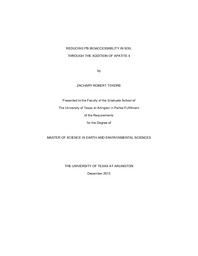| dc.description.abstract | This study was an investigation of the bioaccessibility of Pb in the presence of phosphate acting as an immobilizing constituent in the form of fish bone material, specifically Apatite II. Phosphate-induced Pb immobilization refers to the process by which Pb ions replace calcium ions and form insoluble Pb-phosphate. A commercially available A-horizon soil was spiked with dried Pb-bearing paint containing various Pb forms (e.g., carbonates, sulfates, and oxides). The paints were added to the soil at 2% weight for weight (w/w). The paints (in solid form) were initially ground and sieved through a <100 micron mesh to provide a <100 μm size fraction. Once a paint was mixed with a soil, typically in duplicate, replicates were either retained or further amended with Apatite II. Soil columns were created using a series of 250 mL syringes individually filled with each paint spiked soil sample, some of which were amended with Apatite II at 5% w/w. For six months the columns were eluted regularly with Milli-Q water and at six months, subsamples were removed from the top of each soil column in order to evaluate any change in potential bioaccessibility of the Pb associated with soil. Thus, this work focuses on the bioaccessibility of Pb in a group of soil column samples based on the weak acid solubility of the Pb in the soil, and on an electron microscopic analysis of the Pb in the soils. Each soil column sample was subjected to an in vitro relative bioaccessibility assessment (RBA), in which a simulated gastric fluid (SGF) was used to simulate and project the effects of digestion on the Pb contaminated soils. The SGF was intended to mimic the acidic quality of the human stomach and yields approximate results of how much Pb could potentially be released into the acid solution through human digestion. The SGF solution was essentially composed of hydrochloric acid (HCL) adjusted to a pH of 2.5. From the soil columns, 3g of soil were removed and 1g was added to 100 mL of SGF and then tumbled for 1 hour at 37°C in a modified toxicity characteristic leaching procedure system. After this time a sample of the fluid was collected an the amount of Pb in the fluid was measured. Photomicrographs of each soil column were obtained using a scanning electron microscope with a back-scattered electron detector and an energy dispersive x-ray spectrometer. These digital images were used to determine the chemical nature of various Pb-bearing constituents within each soil sample. This study concluded that the addition of Apatite II led to a reduction in the bioaccessibility of Pb in some of the test soils, determined through differences in in vitro RBA and through the recognition of Pb-phosphate particle phases in the soil samples. Previous studies have found that the addition of Apatite II as a remediation technique for Pb contaminated soil can be successful, however this is the first time that Pb contamination of the soil has been in the form of Pb-bearing paint. Furthermore, this study is notable for identifying changes in Pb bioaccessibility of Pb derived from Pb-bearing paint over the short time-span of six months. | en_US |

